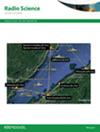Generalized force method for point-to-point ray tracing in anisotropic ionosphere: Implementation and applications to NeQuick2 and IGRF13 models
IF 1.5
4区 地球科学
Q3 ASTRONOMY & ASTROPHYSICS
引用次数: 0
Abstract
The generalized force method, previously developed for an isotropic inhomogeneous ionosphere, exploits the knowledge about the character of the extrema of the phase distance—where high ionospheric rays correspond to minima and low rays to saddle points—to systematically find all relevant rays between fixed points, thereby enabling efficient global point-to-point ray tracing. In this article, the generalized force approach is extended to magneto-active, anisotropic ionosphere by locating minima and saddle points of a more general phase distance functional where trial functions include both the candidate ray path geometry and the orientation of the wavefront. For both O and X modes, the rays are found using an optimization algorithm guided by the generalized force whose definition depends on the ray type. The generalized force method, implemented in the form of computer software, is applied to problems of oblique sounding in realistic ionosphere described by NeQuick2 and IGRF13 models. The results of the ionogram simulations demonstrate the method's ability to solve routine problems of ionospheric ray tracing and show its potential in solving various inverse problems, as well as in verifying and correcting models of the ionosphere.各向异性电离层点对点射线追踪的广义力法:在NeQuick2和IGRF13模型中的实现与应用
以前为各向同性非均匀电离层开发的广义力法利用了相距离极值的特征——电离层射线高对应于最小值,低对应于鞍点——系统地找到固定点之间的所有相关射线,从而实现有效的全球点对点射线追踪。在本文中,通过定位更一般的相距离函数的极小点和鞍点,将广义力方法扩展到磁主动、各向异性电离层,其中试函数包括候选射线路径几何形状和波前方向。对于O和X两种模式,采用广义力指导下的优化算法来寻找射线,广义力的定义取决于射线类型。将广义力法以计算机软件的形式实现,应用于NeQuick2和IGRF13模型描述的真实电离层倾斜探测问题。电离层模拟结果表明,该方法能够解决电离层射线追踪的常规问题,并显示其在解决各种反问题以及验证和校正电离层模型方面的潜力。
本文章由计算机程序翻译,如有差异,请以英文原文为准。
求助全文
约1分钟内获得全文
求助全文
来源期刊

Radio Science
工程技术-地球化学与地球物理
CiteScore
3.30
自引率
12.50%
发文量
112
审稿时长
1 months
期刊介绍:
Radio Science (RDS) publishes original scientific contributions on radio-frequency electromagnetic-propagation and its applications. Contributions covering measurement, modelling, prediction and forecasting techniques pertinent to fields and waves - including antennas, signals and systems, the terrestrial and space environment and radio propagation problems in radio astronomy - are welcome. Contributions may address propagation through, interaction with, and remote sensing of structures, geophysical media, plasmas, and materials, as well as the application of radio frequency electromagnetic techniques to remote sensing of the Earth and other bodies in the solar system.
 求助内容:
求助内容: 应助结果提醒方式:
应助结果提醒方式:


